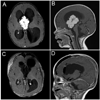Surgical treatment of brain tumors in infants younger than six months of age and review of the literature
- PMID: 22120270
- PMCID: PMC3292637
- DOI: 10.1016/j.wneu.2011.09.012
Surgical treatment of brain tumors in infants younger than six months of age and review of the literature
Abstract
Objective: Brain tumors are rare in infants who are younger than six months of age. These tumors can be challenging to treat surgically. We analyzed a modern series of patients treated by a multidisciplinary team at a tertiary care center and performed a literature review of this unique population.
Methods: Retrospective clinical data were collected for patients surgically treated for intracranial mass lesions at The Children's Hospital of Philadelphia from 1998 to 2007. Dermoid cysts and other skull-based lesions were excluded from the analysis.
Results: Sixteen patients younger than six months of age underwent surgery for primary intracranial mass lesions. The median age of the patients at surgery was 5.2 months (range, 1.4-6 months of age). Children most often presented with a bulging fontanelle, hydrocephalus, or macrocephaly (seven patients). Vomiting was seen in five patients, cranial nerve palsies in one patient, and seizures in three patients. All patients had tumor resections and postoperatively were monitored in the intensive care unit. The final pathology consisted of atypical teratoid/rhabdoid tumor (three patients), primitive neuroectodermal tumor/medulloblastoma (three patients), choroid plexus papilloma (two patients), astrocytoma (two patients), ganglioglioma (two patients), desmoplastic infantile ganglioglioma (two patients), glioblastoma multiforme (one patient), and choroid plexus carcinoma (one patient). Two intraoperative deaths occurred. Of the surviving 14, a gross total resection was achieved in four. Adjuvant therapy was determined by a multidisciplinary team composed of neuro-oncology, neurosurgery, and radiation oncology. Seven patients were treated with chemotherapy, and one patient had proton beam therapy. Five-year overall survival was 45%. The eight surviving patients had neurological sequelae, and developmental outcome was variable.
Conclusions: Brain tumors are uncommon in children younger than six months of age. Patients present with a variety of tumor pathologies. Children who survive have neurological sequelae. More studies are necessary to understand the impact that different treatment options, tumor pathology, and tumor location have on neurological outcome.
Copyright © 2012 Elsevier Inc. All rights reserved.
Conflict of interest statement
None of the authors has any disclosures or conflicts of interest.
Figures



References
-
- Alexiou GA, Stefanaki K, Sfakianos G, Prodromou N. Desmoplastic infantile ganglioglioma: a report of 2 cases and a review of the literature. Pediatr Neurosurg. 2008;44:422–425. - PubMed
-
- Allen JC. What infants can teach us about brain tumors. N Engl J Med. 1993;328:1780–1781. - PubMed
-
- Araki K, Aori T, Takahashi JA, Nozaki K, Nagata I, Kikuchi H, Yokoyama M, Hattori H, Akiyama Y, Kubota Y, Yokomizo H. [A case report of choroid plexus carcinoma] No Shinkei Geka. 1997;25:853–857. - PubMed
-
- Arico M, Raiteri E, Bossi G, Giordana MT, Corbella F, Locatelli D, Pezzotta S. Choroid plexus carcinoma: report of one case with favourable response to treatment. Med Pediatr Oncol. 1994;22:274–278. - PubMed
-
- Arnstein LH, Boldrey E, Naffziger HC. A case report and survey of brain tumors during the neonatal period. J Neurosurg. 1951;8:315–319. - PubMed
Publication types
MeSH terms
Grants and funding
LinkOut - more resources
Full Text Sources
Medical

